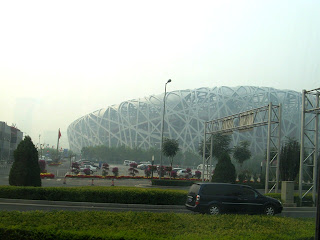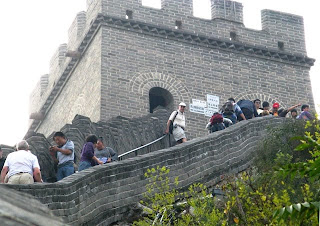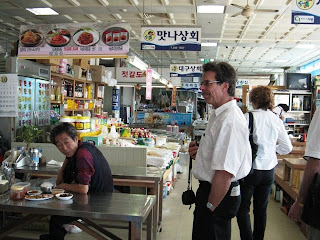Slow Boat to China
A cruise from Vancouver to Shanghai in 27 days
Tuesday, October 26, 2010
China or the Nation at the Center of the Earth - Shanghai
China or the Nation at the Center of the Earth
Fortunately, we did not see any major traffic tie-ups. Our Chinese tour guide told us that the air was relatively clear and the traffic relatively light because China was nearing the end of a week long public holiday and most people were on vacation.
Friday, October 22, 2010
Korea in Less than Four Hours
When the Silver Shadow sailed into Busan, formerly Pusan, I think I expected to see a beach resort. For more than fifty years, Pusan has been an R & R site for U.S. troops stationed in Korea. That is about all I knew about it aside from the tour book statement that it is a large container port.
It is definitely a large port. We docked at a pier several miles from the city center. The shuttle bus to the center of the city took us past a bustling seaport, huge shipyards busy building ships and many residential neighborhoods that look a lot like Chinatown in New York except that the signs in Korean don't look a lot like Chinese.
Although the cruise line offered a number of tours, most included temples and shrines in which were not particularly interested. Nor were we interested in a tour of a porcelain factory. Michael and I decided to do our own tour of central Busan on foot. I think the experiences we have enjoyed most on this cruise have been our own explorations of how people live in the exotic cultures we have seen. I definitely include the Alaskan ports in the exotic culture category
.
The absolute highlight of the morning was our visit to the Busan fish market. We saw more kinds of mostly live fish and seafood than I have ever seen in my life. There were any number of fresh caught and dried fish for sale on the sidewalks for blocks surrounding the market. The market itself occupied a two-story building that seemed half a mile long. Tanks of wriggling creatures met the eye in every direction. I think the live sea slugs were the creepiest. Many fish I could not identify, nor would I have any idea how to prepare them. There was a restaurant area on the second floor along the windows facing the bay. It had very low tables and benches that were barely above floor level. Camera shy women worked at stalls along the aisle. They were setting up shop for the lunch crowd, busily slicing, dicing, and dropping fish parts into kettles and pans. Had it been later in the day I might have been tempted to have lunch there. I have included a photo of some shopkeepers lunching over the live fish.
Several blocks in from the main drag was a huge multi block open-air market. Vendors on each street block sold similar items from storefronts that were more like booths than proper stores. I remarked to Michael that it looked like an open-air Wal-Mart. He replied, "Where do you think Wal-Mart gets its stuff?" It's true. The goods for sale looked exactly like those found in U.S. discount stores. I didn't see anything less expensive than it would have been in the U.S. except for some Rolexes and Calvin Kline, Gucci and the like knock-off merchandise. Later I saw a number of fellow cruise passengers toting high-end merchandise packages back to the ship. I hope whatever they bought doesn't fall apart the first time they wear it.
In Japan, souvenir merchandise was mostly labeled "made in China." In Korea, not so much. The Korean gift items were better quality than the Japanese China-made items. The open air market wasn't as much a tourist trap as a market selling to locals. I enjoyed watching the food vendors set up and the men with push carts of produce. One of them just about ran over Michael. He was not about to yield to any pedestrian.
We visited the Busan Tower, an observation point in a park on a hill in the center of downtown Busan. The views from thirty storys up were spectacular. In every land direction we saw a city of very modern buildings surrounded by miles of high rise apartments. The skyscrapers, the container port, the shipyards were massive. Next to the tower, there was a museum of world musical instruments. It is a small gem. We especially (Michael especially) enjoyed playing various drums and marimba like instruments
.
Korea was far less polite and regimented than Japan. It, too, is very prosperous. The Koreans are much more influenced by American culture. The shuttle bus back to the ship had a video of a Korean Shakira singing and gyrating over and over.
Our visit was much too short to make any real judgments. I would, however, like to go back and see more of the country.
















































